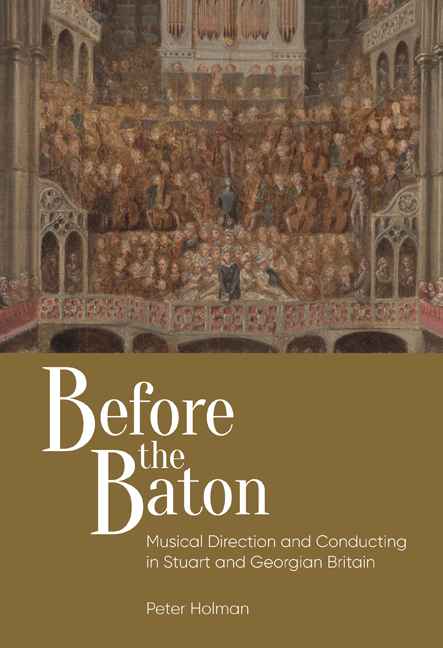Book contents
- Frontmatter
- Dedication
- Contents
- List of Illustrations
- Foreword
- Acknowledgements
- Note to the Reader
- List of Abbreviations
- Prelude To Beat or Not to Beat: The Continental Context
- Part I Directing Choral Music
- Chapter 1 ‘Heard but not Seen’: Leading Anglican Cathedral Music from the Organ
- Chapter 2 ‘With a Scroll of Parchment or Paper, in Hand’: Large- Scale Choral Music
- Chapter 3 ‘Accompanied all along on the Organ by his Own Inimitable Hand’: Handel and the Direction of his Oratorios
- Chapter 4 ‘The Conductor at the Organ’: The Oratorio Tradition after Handel
- Part II Directing Opera and Theatre Music
- Chapter 5 ‘That Ridiculous Custom’: From Devolved Direction to Centralized Time-Beating in Seventeenth-Century Theatre Music
- Chapter 6 ‘Il maestro al cembalo’: Directing Opera and Theatre Music from the Harpsichord
- Chapter 7 ‘A New Discipline and a New Style of Playing’: Directing Opera and Theatre Music from the Violin
- Chapter 8 ‘That Powerful Sovereign, the Conductor’: From the Piano to the Rostrum
- Postlude Superconductors or Semiconductors? Lessons for Today
- Bibliography
- Index
- Miscellaneous Endmatter
Chapter 3 - ‘Accompanied all along on the Organ by his Own Inimitable Hand’: Handel and the Direction of his Oratorios
Published online by Cambridge University Press: 11 September 2020
- Frontmatter
- Dedication
- Contents
- List of Illustrations
- Foreword
- Acknowledgements
- Note to the Reader
- List of Abbreviations
- Prelude To Beat or Not to Beat: The Continental Context
- Part I Directing Choral Music
- Chapter 1 ‘Heard but not Seen’: Leading Anglican Cathedral Music from the Organ
- Chapter 2 ‘With a Scroll of Parchment or Paper, in Hand’: Large- Scale Choral Music
- Chapter 3 ‘Accompanied all along on the Organ by his Own Inimitable Hand’: Handel and the Direction of his Oratorios
- Chapter 4 ‘The Conductor at the Organ’: The Oratorio Tradition after Handel
- Part II Directing Opera and Theatre Music
- Chapter 5 ‘That Ridiculous Custom’: From Devolved Direction to Centralized Time-Beating in Seventeenth-Century Theatre Music
- Chapter 6 ‘Il maestro al cembalo’: Directing Opera and Theatre Music from the Harpsichord
- Chapter 7 ‘A New Discipline and a New Style of Playing’: Directing Opera and Theatre Music from the Violin
- Chapter 8 ‘That Powerful Sovereign, the Conductor’: From the Piano to the Rostrum
- Postlude Superconductors or Semiconductors? Lessons for Today
- Bibliography
- Index
- Miscellaneous Endmatter
Summary
❧ Handel's First Public Oratorio Performances
HANDEL was in mid-career before he put on an oratorio in public in London. His first English oratorio, Esther HWV 50a, was written for a private performance, probably in 1720, at Cannons, the country house near Edgware of James Brydges, Earl of Carnarvon and later Duke of Chandos. His public oratorio performances began with the revision of Esther HWV 50b (HT, 2/5/1732), that transformed it from a relatively short chamber work (22 numbers written for about 10 singers and 20 instrumentalists) into a full-length largescale work (33 numbers for eight soloists, a choir singing in up to eight parts, and an orchestra including pairs of recorders, oboes, bassoons and horns with three trumpets, timpani, strings in up to seven parts and continuo). Handel was apparently inspired or provoked into making the change by the performance of the Cannons version at the Crown and Anchor Tavern on 23 February 1732 with Chapel Royal singers led by Bernard Gates, and more immediately by a pirate performance at York Buildings on 20 April by unidentified performers, who may have been connected to the English opera company recently established by John Frederick Lampe and Henry Carey, perhaps with the young Thomas Arne. Handel began to perform oratorios in public partly to take advantage of the regulation of 1712 that forbade operas and plays in the London theatres on Wednesdays and Fridays during Lent, which left the field open for non-staged musical performances.
In performing Esther with large forces Handel was faced with several linked dilemmas, since oratorio was a novel genre – novel at least in England – that mixed elements of opera and church music, each associated with a different method of direction. Which system should he use? Should he stand and beat time as he had done in his large-scale choral music (Ch. 2)? Or should he direct from the harpsichord as in Italian opera, leading the continuo group and influencing the orchestra by his playing (Ch. 6)? And since the 1732 Esther required a choir, which needed the support of an organ, how was it to be used and where should it be placed?
- Type
- Chapter
- Information
- Before the BatonMusical Direction and Conducting in Stuart and Georgian Britain, pp. 111 - 140Publisher: Boydell & BrewerPrint publication year: 2020



